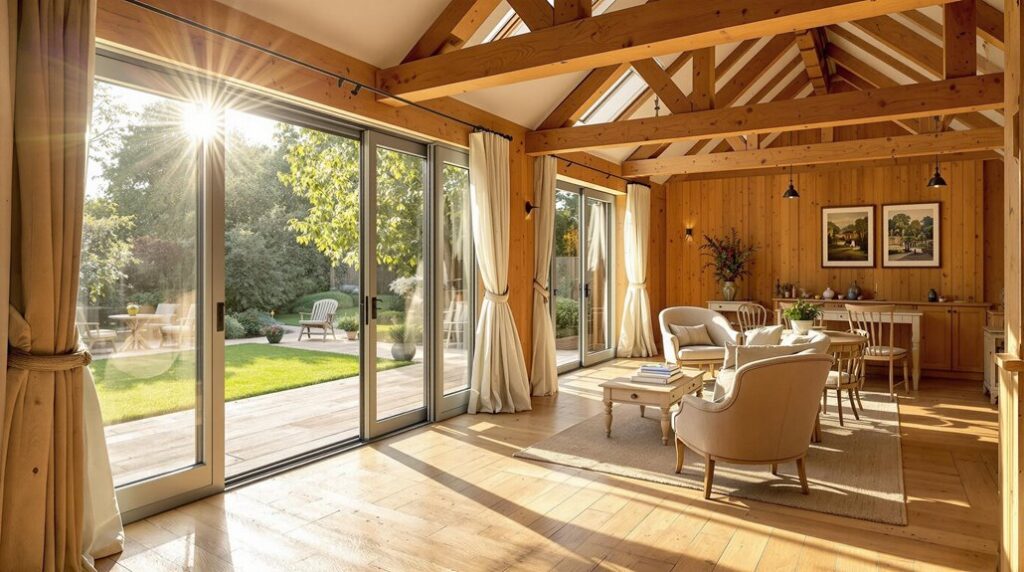I’ve watched countless homeowners struggle with extensions that feel disconnected from their original property, creating awkward changes that diminish rather than enhance their living space. When you’re planning an oak extension, you’ll face the same critical challenge: how do you seamlessly blend rustic charm with modern functionality while respecting your home’s existing character? The answer lies in understanding specific design principles and construction techniques that I’ll share with you, starting with the most overlooked aspect that determines success or failure.
Key Takeaways
- Oak frames offer exceptional durability and rustic charm, strengthening over time with mortise-and-tenon joints for authentic architectural character.
- Curved garden rooms with 360° panoramic views and hammerbeam trusses create stunning focal points that blend seamlessly with outdoor spaces.
- Double-height extensions combining steel and oak provide expansive glazing and vaulted ceilings for maximum natural light and rustic appeal.
- Barn-style kitchen-diner extensions with floor-to-ceiling glazing create open-plan living spaces that enhance both functionality and rustic atmosphere.
- Match rooflines and replicate architectural features like gables or archways to ensure seamless integration with your existing home’s character.
Transform Your Living Space With Curved Oak Structures and Panoramic Views
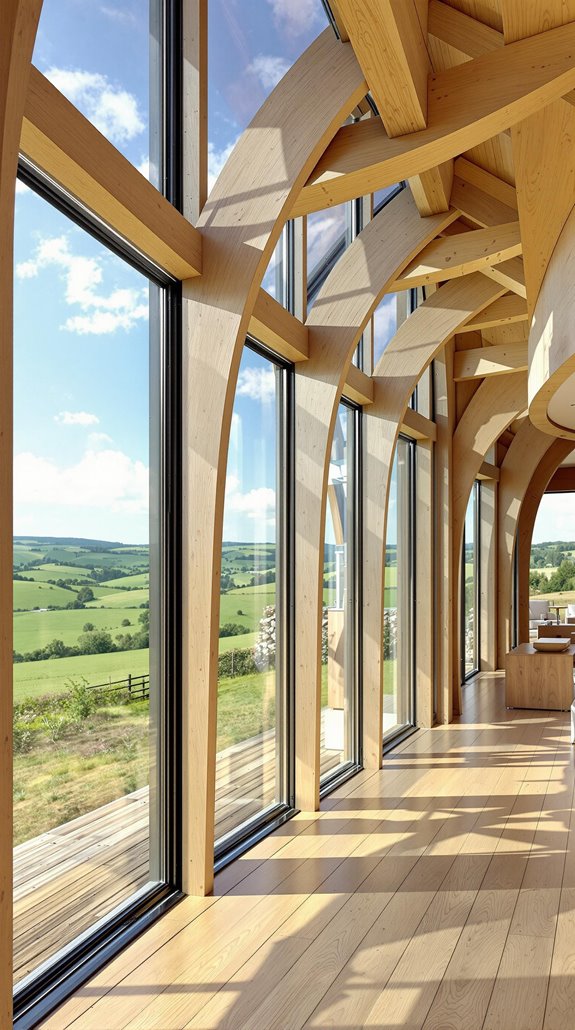
When you’re planning a curved oak extension, start by identifying sight lines that will maximize your property’s natural views. I’ll help you understand how faceted windows create 360° panoramic views that alter your living experience.
Focus on steel I-beams for cantilevered corners – they’ll eliminate supporting posts that block your sightlines. You’ll want floor-to-ceiling glazing with narrow frames to accommodate oak’s natural movement while flooding your space with light. Additionally, consider incorporating modern roofing materials to enhance the durability and energy efficiency of your extension.
Consider partial glass roofs in orangeries for balanced illumination and thermal efficiency. The curved knee braces and roundel designs will integrate seamlessly with your existing architecture.
Your curved design creates seamless indoor-outdoor shifts through retractable glazed doors, expanding your living areas visually. This approach reduces artificial lighting needs by 40% while adding character that distinguishes your home. Budget approximately £2,500-£3,000 per m² for your oak frame extension, as costs vary based on glazing choice and structural complexity.
Double-Height Extensions: Steel and Oak Combinations for Modern Appeal
Although double-height extensions require careful structural planning, combining steel and oak creates the perfect balance between dramatic space and modern functionality. I’ll show you how steel reinforcements support those expansive glazing panels you’re dreaming of, while exposed oak beams deliver that rustic character we all love.
Your investment ranges from £1,500–£2,500 per m², with glazing and steel components accounting for 30–40% of costs. I recommend floor-to-ceiling glazing with narrow-profile steel frames—they’ll maximize natural light while complementing oak’s natural movement. Consider black aluminium bifold doors for contemporary contrast, and don’t overlook triple glazing for energy efficiency—a crucial factor in modern home design.
Steel columns provide minimalist structural support, letting oak’s organic texture shine. You’ll create versatile spaces perfect for open-plan living that seamlessly connects indoor and outdoor areas. Oak’s warm material properties add natural texture that enhances the overall ambiance of your extended living space.
Seamless Integration Techniques for Blending New With Existing Architecture
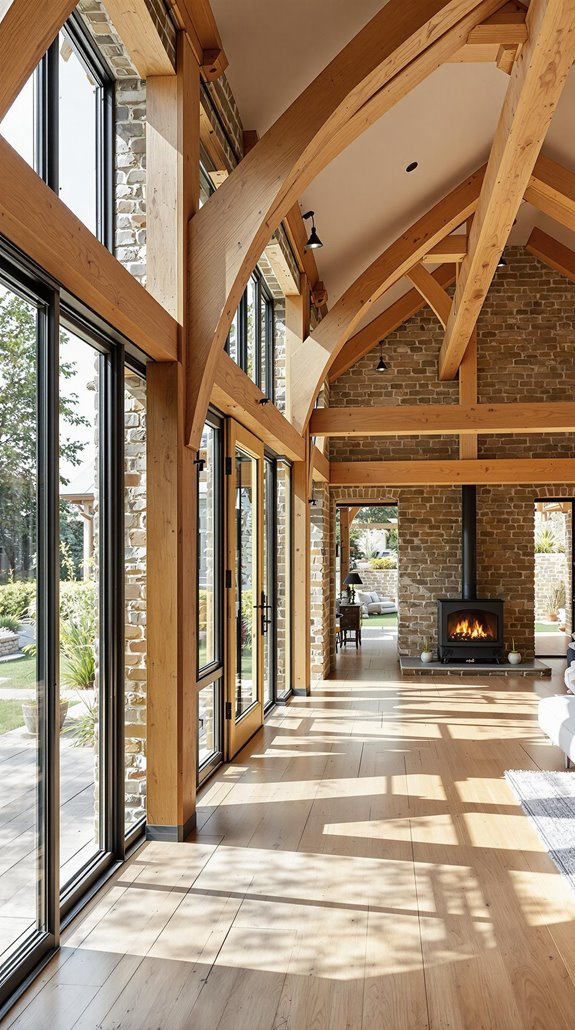
Creating a harmonious oak extension requires meticulous attention to your existing home’s architectural DNA—I’ll guide you through the essential techniques that make new additions look like they’ve always belonged.
Start by matching your rooflines, proportions, and materials to maintain visual continuity. I recommend replicating key architectural features like gables or archways that define your home’s character. Use complementary external finishes—brick, render, or stone—that mirror your main building. This careful consideration of planning permissions ensures that your extension aligns with local regulations and enhances the overall appeal of your property.
Align floor levels flush between spaces to eliminate awkward steps and create seamless changes. Extend your existing flooring materials uninterrupted from original rooms into the new space.
Choose green oak framing with mortise-and-tenon joints for authentic connections. Pre-assemble frames off-site for precision fitting, and design self-supporting structures that won’t compromise your original building’s integrity. Oak acts as a carbon sink, making your extension environmentally beneficial while maintaining structural excellence.
Material Benefits: Why Oak Frames Stand the Test of Time
Beyond achieving visual harmony, you’ll want to understand why oak frames deliver unmatched performance for your extension project. I’ve seen oak structures from centuries past still standing strong, proving this material’s exceptional durability. You’re investing in a framework that resists rot, insects, and fungal damage far better than softwoods. Additionally, incorporating energy-efficient designs into your extension can further enhance the benefits of using oak, as these designs work well with natural materials.
Here’s what makes oak frames superior: they actually strengthen as they dry, with joints tightening naturally over time. You’ll get a strength-to-weight ratio exceeding steel, supporting expansive open layouts without compromise. The wood shrinks predictably (under 5%) while gaining structural integrity.
Your extension will outlast conventional builds by centuries, requiring minimal maintenance. You’re joining homeowners who’ve chosen materials that weather storms, resist fire, and maintain stability through seasonal changes—creating lasting value for generations. This approach represents an eco-friendly choice that utilizes renewable resources with minimal processing requirements.
Navigating Planning Permission for Your Oak Extension Project
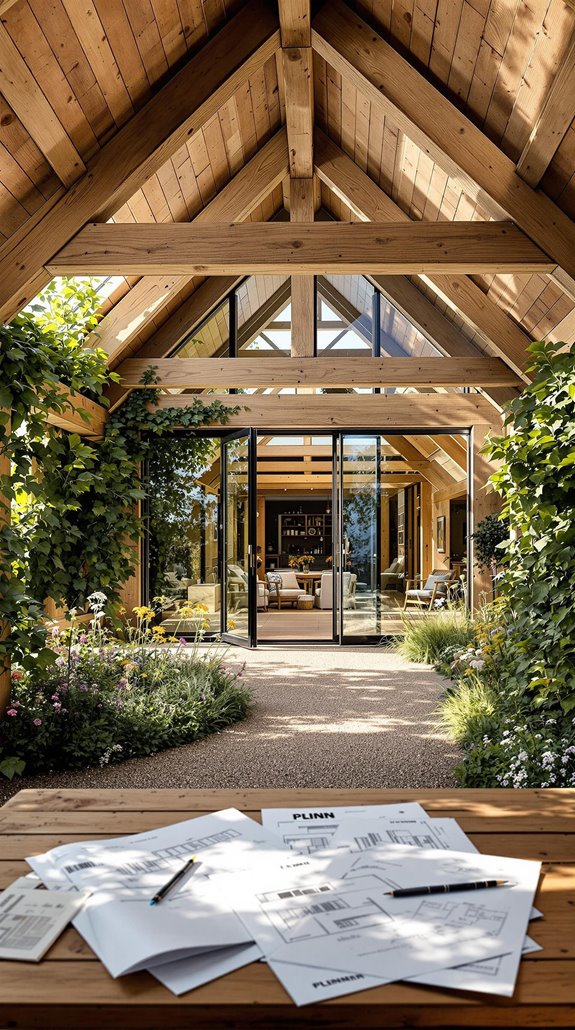
How do you guarantee your oak extension project clears planning hurdles without costly delays? I’ll walk you through the essential steps that’ll keep your project on track.
First, check if your property falls under Article 4 Directions by contacting your local council’s planning department. These override permitted development rights in conservation areas and AONBs.
Next, measure your extension carefully. Rear extensions on detached homes can extend 4m, while semi-detached and terraced properties are limited to 3m. Your total extension coverage can’t exceed 50% of your original house’s surrounding land. It’s crucial to understand the maximum allowable extension sizes to avoid any potential issues.
Document your “original house” footprint—this excludes any post-1948 extensions. Use the Planning Portal’s interactive guides for real-time checks, and remember that materials must match your existing exterior appearance.
Before starting any work, verify requirements with your Local Planning Authority as regulations can vary significantly between different council areas and may affect your oak extension’s approval timeline.
Cost-Effective Strategies for Oak Frame Construction
While oak frame construction offers timeless beauty, smart cost management transforms this premium building method into an achievable investment. I’ll share proven strategies that keep your extension project within budget.
Start by targeting barn-style layouts—they’ll cost you £450 per m² versus £850 for complex designs. I recommend prioritizing open-plan spaces to minimize partition walls and labor hours. Your oak frame should represent one-third to half your total budget, with overall costs around £1,700–£1,950 per m². Engage an experienced oak frame designer early in the process to prevent costly design issues and maximize the structural benefits of oak. Additionally, consider energy-efficient features to further enhance the value of your extension.
Choose offsite prefabrication to slash labor expenses by 15–20% while reducing construction time by 30–50%. Self-manage subcontracting rather than accepting turnkey solutions—you’ll save 10–15% immediately. Don’t forget hidden costs: budget £500–£1,000 for legal fees, £335 for planning permission, and £500–£1,000 for building regulations. Smart planning delivers exceptional results.
Popular Oak Extension Configurations to Inspire Your Design
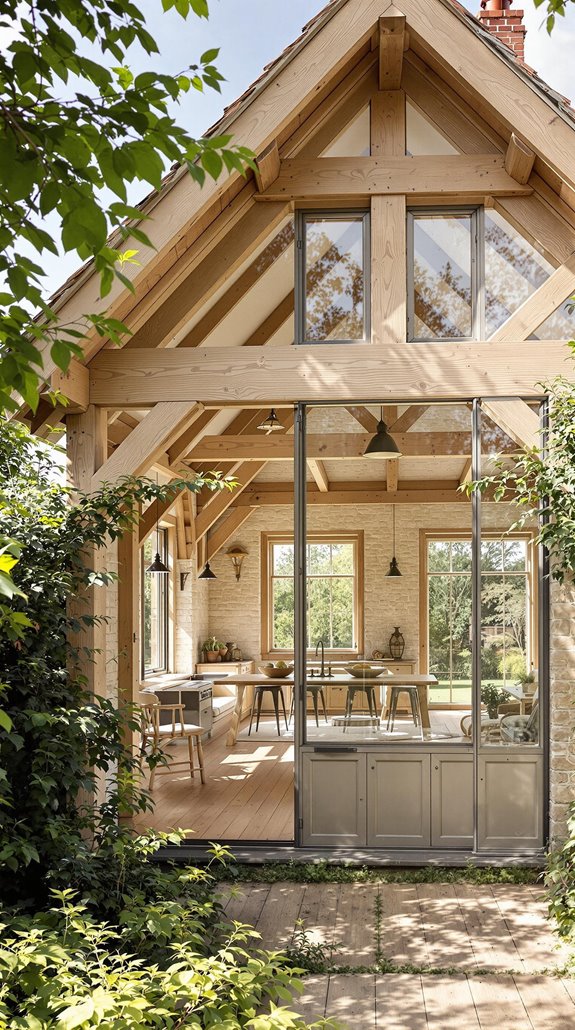
When planning your oak extension, you’ll discover that certain configurations consistently deliver exceptional results across different property types. I’ll walk you through the most popular designs that fellow homeowners are choosing.
For single-storey additions, consider a glazed sunroom with vaulted ceilings—it’s perfect for maximizing garden views. Kitchen-diner extensions using barn-style structures with exposed trusses create that coveted open-plan feel we all want, making it an ideal choice for enhancing living space in your home.
If you’re thinking vertically, two-storey side extensions effectively double your floor space while adding bedrooms or offices. Gable-ended designs with double-height entrances make stunning first impressions, ensuring that your extension adds value and style to your property.
For specialized needs, curved garden rooms with 360° views are increasingly popular, while hammerbeam trusses support wide spans without interior columns. The construction phase moves quickly since much of the off-site work is completed before assembly begins on your property. These proven configurations guarantee your investment delivers both functionality and visual impact.
Conclusion
I’ve shown you seven practical approaches to creating your oak extension. Start by sketching your preferred configuration, then contact your local planning office to discuss requirements. Get quotes from oak frame specialists, compare steel-oak combinations for budget efficiency, and prioritize seamless integration techniques. Remember, oak’s durability makes it worth the investment. Take measurements, create your timeline, and begin transforming your home with these time-tested methods.
References
- https://www.homebuilding.co.uk/ideas/oak-frame-extension-ideas
- https://www.self-build.co.uk/amazing-oak-frame-extensions/
- https://www.homebuilding.co.uk/ideas/before-and-after-dated-cottage-transformed-by-small-extensions
- https://oakbydesign.co.uk/100-amazing-oak-frame-extension-ideas/
- https://uk.pinterest.com/katiebond338/oak-frame-extension/
- https://foxtailoak.co.uk/oak-frame-extensions-benefits/
- https://www.radnoroak.co.uk/supporting-products/oak-extensions
- https://www.anthony-hicks.co.uk/oak-buildings/oak-framed-houses
- https://www.oakwrights.co.uk/case-studies/a-two-storey-oak-frame-home-extension-nestled-in-a-cotswold-village
- https://www.oakmasters.co.uk/products/oak-extensions/project/large-double-storey-glazed-oak-extension/

